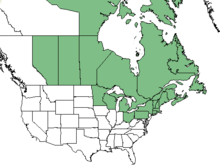Lonicera villosa, also known as mountain fly honeysuckle, is a species of honeysuckle native to North America.[1]
| Lonicera villosa | |
|---|---|

| |
| Scientific classification | |
| Kingdom: | Plantae |
| Clade: | Tracheophytes |
| Clade: | Angiosperms |
| Clade: | Eudicots |
| Clade: | Asterids |
| Order: | Dipsacales |
| Family: | Caprifoliaceae |
| Genus: | Lonicera |
| Species: | L. villosa
|
| Binomial name | |
| Lonicera villosa (Michx.) Schult.
| |

| |
| Lonicera villosa range | |
Growth
editLonicera villosa is a small bush, ranging from 1 to 5 feet in height.[2] The elongated white flowers grow in clusters, while its blue berries grow in pairs.
Distribution
editLonicera villosa occurs across the Northern and Northeastern United States, as well as Central, Eastern, and Northern Canada.[3]
Uses
editThe berries of Lonicera villosa are edible and sometimes mistaken for blueberries.
References
edit- ^ "Lonicera villosa". Integrated Taxonomic Information System. Retrieved 6 May 2018.
- ^ "Lonicera villosa". Plants for a Future. Retrieved 7 May 2018.
- ^ NRCS. "Lonicera villosa". PLANTS Database. United States Department of Agriculture (USDA). Retrieved 6 May 2018.
